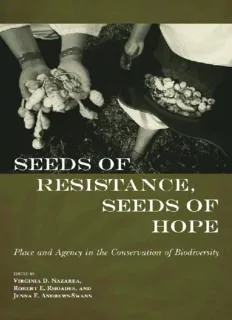
Seeds of Resistance, Seeds of Hope: Place and Agency in the Conservation of Biodiversity PDF
Preview Seeds of Resistance, Seeds of Hope: Place and Agency in the Conservation of Biodiversity
Seeds of Re sis tance, Seeds of Hope Seeds of Re sis tance, Seeds of Hope Place and Agency in the Conservation of Biodiversity Edited by VIRGINIA D. NAZAREA, ROBERT E. RHOADES, AND JENNA E. ANDREWS-S WANN TUCSON The University of Arizona Press © 2013 The Arizona Board of Regents All rights reserved. www. uapress .arizona .edu Library of Congress Cataloging- in-P ublication Data Seeds of re sis tance, seeds of hope : place and agency in the conservation of biodiversity / edited by Virginia D. Nazarea, Robert E. Rhoades, and Jenna Andrews- Swann. pages cm Includes bibliographical references and index. ISBN 978-0 - 8165- 3014- 4 (hardback : alk. paper) 1. Agrobiodiversity conservation—Cross-c ultural studies. 2. Food security—Cross- cultural studies. 3. Local foods—Cross- cultural studies. 4. Seeds—Cross- cultural studies. I. Nazarea, Virginia D. (Virginia Dimasuay), 1954–, editor of compilation. II. Rhoades, Robert E., editor of compilation. III. Andrews- Swann, Jenna, 1980–, editor of compilation. S494.5.A43S39 2013 333.95'316—dc23 2013011198 Publication of this book is made possible in part by the proceeds of a permanent endowment created with the assistance of a Challenge Grant from the National Endowment for the Humanities, a federal agency. Manufactured in the United States of America on acid- free, archival-q uality paper containing a minimum of 30% post- consumer waste and pro cessed chlorine free. 18 17 16 15 14 13 6 5 4 3 2 1 This volume—s immered in the love of collard greens, black- eyed peas, ham hock, corn bread, the American South, and all the world’s resilient Souths—i s dedicated to Bob Rhoades. CONTENTS Preface ix Virginia D. Nazarea Conservation beyond Design: An Introduction 3 Virginia D. Nazarea and Robert E. Rhoades I. Marginality and Memory in Place-B ased Conservation 1 Temptation to Hope: From the “Idea” to the Milieu of Biodiversity 19 Virginia D. Nazarea 2 Apples of Their Eyes: Memory Keepers of the American South 42 Susannah Chapman and Tom Brown 3 Food from the Ancestors: Documentation, Conservation, and Revival of Eastern Cherokee Heirloom Plants 65 James R. Veteto and Kevin Welch 4 Sense of Place and Indigenous People’s Biodiversity Conservation in the Americas 85 Tirso Gonzales 5 Saving Our Seeds: An Indigenous Perspective from Cotacachi, Ecu a dor 107 Magdalena Fueres, Rodrigo Flores, and Rosita Ramos 6 People, Place, and Plants in the Pacifi c Coast of Colombia 115 Juana Camacho viii Contents II. Agency and Reterritorialization in the Context of Globalization 7 Maya Mother Seeds in Res ist ance of Highland Chiapas in Defense of Native Corn 151 Peter Brown 8 Preserving Soybean Diversity in Japan 177 Richard Moore 9 Complementarity and Confl ict: In Situ and Ex Situ Approaches to Conserving Plant Ge net ic Resources 196 Cary Fowler 10 Situated Meanings of Key Concepts in the Regulation of Plant Gen et ic Resources 214 Kristine Skarbø 11 Exile Landscapes of Nostalgia and Hope in the Cuban Diaspora 240 Jenna E. Andrews- Swann 12 When Seeds Are Scarce: Globalization and the Response of Three Cultures 262 Robert E. Rhoades Contributors 287 Index 291 PREFACE Four words that are not normally used, or not used often enough, in rela- tion to the conservation of plant gen et ic resources in par tic ul ar and bio- diversity in general are “res ist ance,” “hope,” “place,” and “agency.” Why focus on these instead of, say, sustainability, rationality, economic value, and pol iti cal strategy? Conservation is all too commonly viewed as something that requires intentionality— a ponderous matter people must deliberate on and methodi- cally execute. Worse yet, it is often regarded as what more developed, formally trained, or well-p ositioned people ought to get less developed, informally educated, and poorly positioned people to think about and do. Environmental management— or its earlier and more lyrical rendition, stewardship— has so colonized our mindset that we often forget that it is a fairly recent invention. Before the conceptual separation of mind and body, and of humans and nature, and before we were preoccupied with dissecting the objective from the subjective, people were part of a highly interactive and largely animate environment on which they depended not only for survival but also, more important, for completion. When the surrounding mountain range is your “mother,” the gnarled tree is your “grandfather,” striped stones are your “scouts,” newly harvested potatoes are your “infants,” and tangled beans are your “sisters,” you do not dis- tance yourself to manage and protect. Indeed, for many cultures that continue to dwell in an intimate-a nimate landscape, such separation and hierarchy are inconceivable, if not downright distressing. This message was brought home to us when, preparing a compila- tion of myths and legends in Cotacachi, Ecu a dor with local collaborators, it became increasingly clear that there was no Quechua equivalent of “conservation,” “management,” or even “stewardship.” As indigenous lead- ers Magdalena Fueres and Rafael Guitarra politely yet emphatically pointed out, the principles igual y igual (among equals) and no paternal- ismo (no paternalism) applied not only to our relationship to them as outsiders who bring in funding for research projects but also, in their ix
Description: